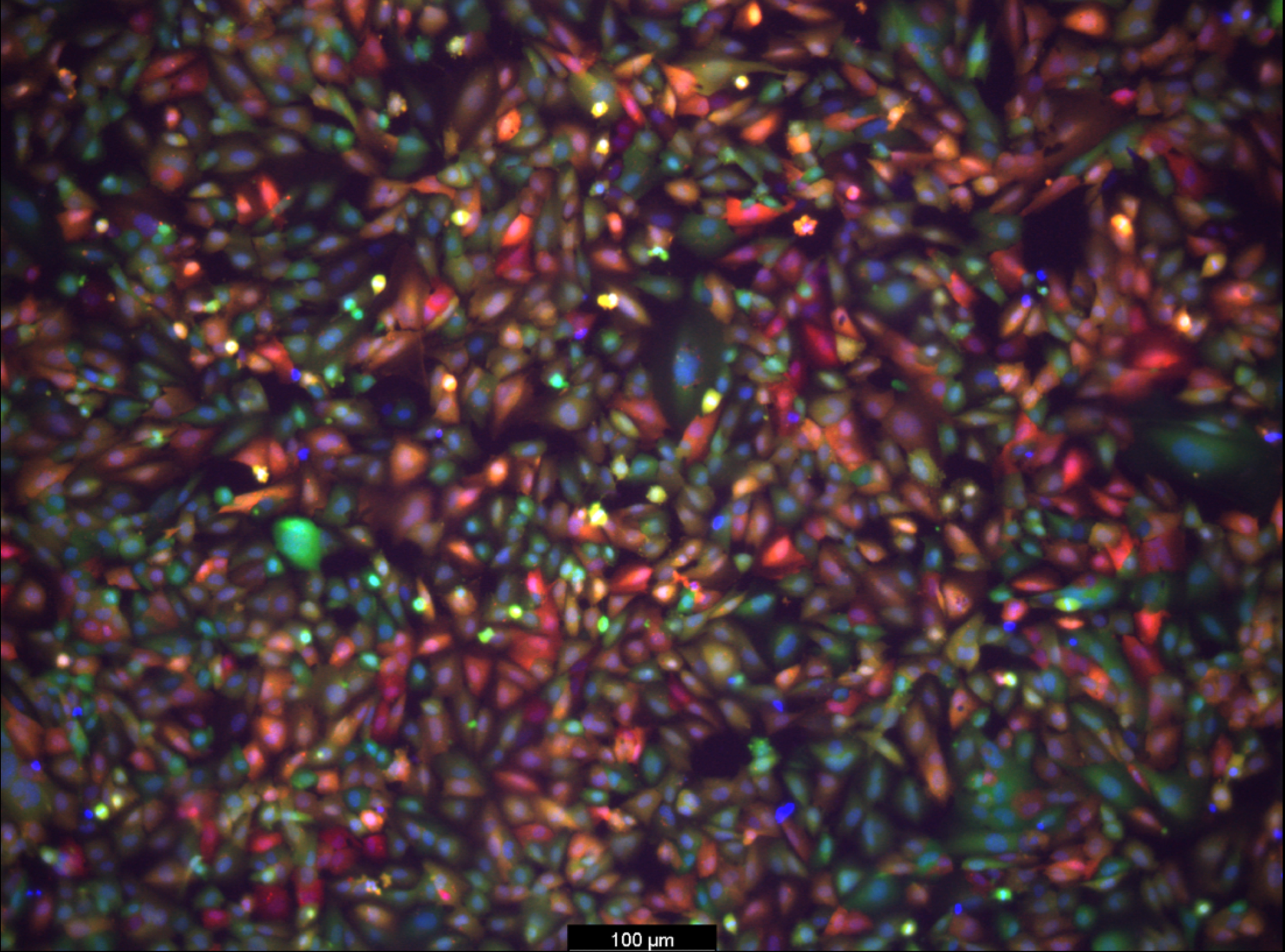Researchers from the University of Pennsylvania, led by Michael Mitchell, are now breaking through the blood-brain barrier, a long-standing biological barrier, by creating a technique that works similarly to giving this mechanism a unique keycard to get past security.
 The blood-brain barrier, a protective cell layer guarding the brain, blocks foreign bodies but also hinders drug delivery, complicating treatment of neurological disorders. Michael Mitchell’s team at the School of Engineering and Applied Science has devised a method to deliver mRNA into the brain using lipid nanoparticles (LNPs), potentially advancing treatments for Alzheimer's disease and seizures. Pictured: Fluorescence microscopy image showing LNPs delivering fluorescent protein (mCherry) mRNA to brain endothelial cells. Cells are shown in green and their nuclei are shown in blue. Cells that are red were transfected by LNPs, where the newly expressed mCherry protein results in red fluorescence. Image Credit: Emily Han
The blood-brain barrier, a protective cell layer guarding the brain, blocks foreign bodies but also hinders drug delivery, complicating treatment of neurological disorders. Michael Mitchell’s team at the School of Engineering and Applied Science has devised a method to deliver mRNA into the brain using lipid nanoparticles (LNPs), potentially advancing treatments for Alzheimer's disease and seizures. Pictured: Fluorescence microscopy image showing LNPs delivering fluorescent protein (mCherry) mRNA to brain endothelial cells. Cells are shown in green and their nuclei are shown in blue. Cells that are red were transfected by LNPs, where the newly expressed mCherry protein results in red fluorescence. Image Credit: Emily Han
The team's discoveries, published in the journal Nano Letters, propose a model that delivers mRNA using lipid nanoparticles (LNPs), providing fresh hope for treating ailments like seizures and Alzheimer's disease—much like resolving technical issues with the control tower without jeopardizing its security.
Our model performed better at crossing the blood-brain barrier than others and helped us identify organ-specific particles that we later validated in future models. It is an exciting proof of concept that will no doubt inform novel approaches to treating conditions like traumatic brain injury, stroke, and Alzheimer’s.
Michael Mitchell, Associate Professor, University of Pennsylvania
Search for the Key
Emily Han, a Ph.D. candidate, first author of the study, and NSF Graduate Research Fellow in the Mitchell Lab, notes that the model’s development began with a quest for the ideal in vitro screening platform.
I was combing through the literature, most of the platforms I found were limited to a regular 96-well plate, a two-dimensional array that can’t represent both the upper and lower parts of the blood-brain barrier, which correspond to the blood and brain, respectively.
Emily Han, Study First Author and PhD Student, NSF Graduate Research Fellow, University of Pennsylvania
Han then investigated high-throughput transwell systems with both compartments but discovered that they were missing a step in the development process since they did not take into consideration the cells’ mRNA transfection.
As a result, she developed a platform that can measure the transfer of mRNA from the blood compartment to the brain and transfect different kinds of brain cells, such as neurons and endothelial cells.
Han further added, “I spent months figuring out the optimal conditions for this new in vitro system, including which cell growth conditions and fluorescent reporters to use. Once robust, we screened our library of LNPs and tested them on animal models. Seeing the brains express protein as a result of the mRNA we delivered was thrilling and confirmed we were on the right track.”
The technology developed by the researchers has the potential to significantly enhance neurological disorder therapies. Currently, it is designed to evaluate a variety of LNPs with different lipid compositions, antibodies, and brain-targeted peptides. Nevertheless, upon intravenous treatment, it can also deliver other drugs like siRNA, DNA, proteins, or tiny molecule drugs straight to the brain.
Furthermore, by concentrating on the blood-placental barrier and the blood-retinal barrier in particular, this technique shows promise for treating diseases connected to pregnancy as well as retinal disorders. Therefore, it is not just restricted to the blood-brain barrier.
Next Steps
The group is excited to screen novel designs and evaluate their efficacy in various animal models using this platform. Working with partners that have sophisticated animal models of neurological illnesses piques their curiosity.
“We are collaborating with researchers at Penn to establish brain disease models. We are examining how these LNPs impact mice with various brain conditions, ranging from glioblastoma to traumatic brain injuries. We hope to make inroads towards repairing the blood-brain barrier or target neurons damaged post-injury,” Han stated.
Michael Mitchell is the director of the Lipid Nanoparticle Synthesis Core at the Penn Institute for RNA Innovation at the University of Pennsylvania and is an associate professor in the Department of Bioengineering in the School of Engineering and Applied Science.
Emily Han is pursuing her Ph.D. at Penn’s School of Engineering and Applied Science.
Marshall Padilla, Rohan Palanki, Dongyoon Kim, Kaitlin Mrksich, Jacqueline Li, Sophia Tang, and Il-Chul Yoon of Penn Engineering are the other authors.
The National Institute of Health (Award DP2 TR002776, Grant No. T90DE030854 and F30HL162465−01A1), the National Science Foundation (Award CBET-2145491 and 1845298), and a Burroughs Wellcome Fund Career Award at the Scientific Interface provided support for this study.
Journal Reference:
Han, E. L., et. al. (2024) Predictive High-Throughput Platform for Dual Screening of mRNA Lipid Nanoparticle Blood–Brain Barrier Transfection and Crossing. Nano Letters. doi:10.1021/acs.nanolett.3c03509